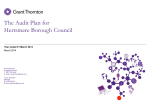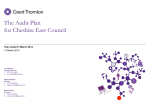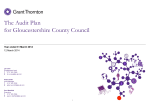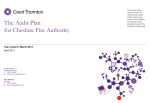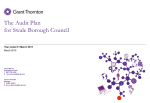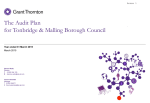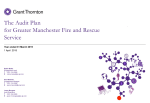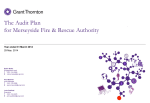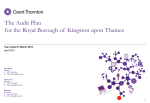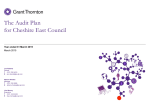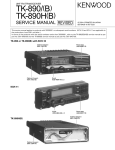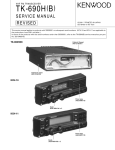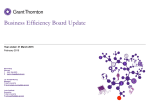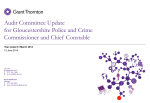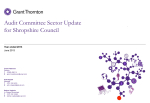Download The Audit Plan – template user guide
Transcript
. The Audit Plan Mayor's Office for Policing and Crime Commissioner of Police of the Metropolis Year ended 31 March 2013 25 March 2013 Paul Grady Engagement Lead T 020 7383 5100 E [email protected] Tom Edgell Manager T 020 7728 3188 E [email protected] Richard Hewes Executive T 020 7728 3250 E [email protected] © 2013 Grant Thornton UK LLP | Richard Smith Manager T 01293 554 101 E [email protected] The contents of this report relate only to the matters which have come to our attention, which we believe need to be reported to you as part of our audit process. It is not a comprehensive record of all the relevant matters, which may be subject to change, and in particular we cannot be held responsible to you for reporting all of the risks which may affect the organisation or any weaknesses in your internal controls. This report has been prepared solely for your benefit and should not be quoted in whole or in part without our prior written consent. We do not accept any responsibility for any loss occasioned to any third party acting, or refraining from acting on the basis of the content of this report, as this report was not prepared for, nor intended for, any other purpose. Contents Section 1. Understanding your business 2. Developments relevant to your business and the audit 3. Our audit approach 4. An audit focused on risks 5. Significant risks identified 6. Other risks 7. Group scope and risk assessment 8. Results of interim work 9. Value for Money 10. Logistics and our team 11. Fees and independence 12. Communication of audit matters with those charged with governance © 2013 Grant Thornton UK LLP | Introduction Purpose This Audit Plan highlights the key elements of our 2012/13 external audit strategy for the Mayor's Office for Policing and Crime (the MOPAC) and the Commissioner of Police of the Metropolis (CPM), the MPS Commissioner. We have compiled the plan based on our audit risk assessment and discussion of key risks with management. in both the Mayor's Office for Policing and Crime (the MOPAC) and the Metropolitan Police Service (the MPS). We report it to the Deputy Mayor for Policing and Crime (DMPC) and the MPS Commissioner as the individuals charged with overall governance for the MOPAC and the CPM respectively. We also report it to the joint MOPAC/MPS Audit Panel for information. Our responsibilities As external auditors we are responsible for performing the audit in accordance with ISAs (UK and Ireland) and to give an opinion on the MPS Commissioner's financial statements and the financial statements of the MOPAC, including the group accounts which consolidate the accounts of the MPS Commissioner. The audit of the financial statements does not relieve management or those charged with governance of their responsibilities for the preparation of the financial statements. The Audit Commission Act 1998 also requires us to assess annually the adequacy of the Deputy Mayor's and MPS Commissioner's arrangements for securing economy, efficiency and effectiveness in its use of resources, known as the value for money conclusion. Communicating the results of audit work We will communicate progress and findings from our audit work to management, the Deputy Mayor for Policing and Crime and the MPS Commissioner at key points during the year. For information we will also communicate this Audit Plan and all subsequent audit reports with the joint MOPAC/MPS Audit Panel. Page 18 of this Plan includes the timescale for the audit and audit reporting which sets this out in more detail. © 2013 Grant Thornton UK LLP | 1 Understanding your business In planning our audit we need to understand the challenges and opportunities you are facing. We set out a summary of our understanding below. Challenges/opportunities 1. A new national framework 2. Managing the finances 3. Delivering major change 4. Build trust and confidence 5. Collaboration Continue to develop governance arrangements in the MOPAC and MPS to support effective decisionmaking and scrutiny by the DMPC. Deliver planned £50 million surplus in 201/13 to support future years' budgets. Deliver the MetChange programme to secure planned improvements in productivity and policing performance. Improve public confidence in policing and victim satisfaction The Home Office expects police bodies to work collaboratively together to deliver efficiencies and improve services. Keep accounting treatments under review in light of any changes in local agreements, emerging national guidance and views from the police sector. Develop detailed plans for delivery of £508 million savings over the next three years, equivalent to 20% of the 2012/13 budget, while as far as possible protecting front-line services. Ensure risks to major change are understood and mitigated through effective senior oversight. Improve staff confidence and pride in the MPS by setting strong example on ethical issues and ensuring fair outcomes. During 2011/12 the MPS focused on sharing its services internally as effectively as possible so had not implemented significant external shared arrangements. Our response We will review governance arrangements as part of our Value for Money Conclusions We will keep proposed accounting for 12/13 under review. © 2013 Grant Thornton UK LLP | We will review the robustness of plans for the delivery of mediumterm efficiency savings while maintaining service capability as part of our work on the Value for Money Conclusion. We will review the governance and oversight arrangements for the MetChange programme as part of our work on the Value for Money Conclusion. We will review management's progress in implementing the Raising Fraud Awareness action plan, summarising the results of workshops We will review progress in maximising efficiencies through improved sharing of MPS services as part of our work on the Value for Money Conclusion. 2 Developments relevant to your business and the audit In planning our audit we also consider the impact of key developments in the sector and take account of national audit requirements as set out in the Code of Audit Practice and associated guidance. Developments and other requirements 1.Financial reporting 2. Legislation 3. Corporate governance 4. Preparation for Stage 2 5. Financial Pressures 6. Other requirements Following the implementation of Police Reform nationally, CIPFA has issued updated accounting guidance (LAAP Bulletin 95), which is relevant to MOPAC and MPS Commissioner. Following the implementation of the Police Reform and Social Responsibility Act, the Government has recognised the need for further legislation to remove anomalies in relation to the taxation status of Chief Constables and statutory accounting overrides. Annual Governance Statements (AGS) The Government anticipates that a second stage transfer of relevant staff and assets from the MOPAC to CPM will take place by 1 April 2014. Managing service provision with less resource The MOPAC is required to submit a Whole of Government accounts pack on which we provide an audit opinion. Explanatory forewords Progress against savings plans The MOPAC and MPS must submit accounting information to the GLA to support preparation of the GLA group accounts. Our response We will ensure: your financial statements comply with the requirements of the CIPFA Code of Practice through our substantive testing of MOPAC and MPS Commissioner's financial statements. © 2013 Grant Thornton UK LLP | We will discuss the impact of the legislative changes with the MOPAC and the MPS Commissioner through our regular meetings with senior management. In practice we plan to rely on the Ministerial statement of 17th January, that the change to exempt the Commissioner from Corporation tax will be applied retrospectively. We will review your arrangements for the production of the MOPAC and MPS Commissioner's AGS. We will review the AGS and the explanatory foreword to consider whether they are consistent with our knowledge. We will continue to review the proposals for a second stage transfer as they develop and consider any impact on our audit of accounts of MOPAC and MPS Commissioner and the value for money conclusion for each. We will review your performance against the 2012/13 budget, including consideration of performance against the savings plan. We will undertake a review of Financial Resilience as part of our VFM conclusion. We will carry out work on the WGA pack in accordance with requirements. We will liaise with the GLA group auditor to ensure his requirements in respect of the MOPAC and MPS Commissioner financial statements are met as part of our audit. 3 Our audit approach Ensures compliance with International Standards on Auditing (ISAs) Global audit technology Understanding the environment and the entity Understanding the business Inherent risks Significant risks Understanding management’s focus Other risks Evaluating the year’s results Material balances Develop audit plan to obtain reasonable assurance that the Financial Statements as a whole are free from material misstatement and prepared in all materiala respects with the CIPFA Code of Practice framework using our global methodology and audit software Devise audit strategy (planned control reliance?) Yes Extract your data No Test controls Test of detail IDEA Substantive Substantive Analyse data analytical analytical Report output using relevant review review to teams parameters Tests of detail General audit procedures Note: a. An item would be considered material to the financial statements if, through its omission or nondisclosure, the financial statements would no longer show a true and fair view. Financial statements Conclude and report Creates and tailors audit programs © 2013 Grant Thornton UK LLP | Stores audit evidence Documents processes and controls 4 An audit focused on risks – MOPAC and MOPAC group We undertake a risk based audit whereby we focus audit effort on those areas where we have identified a risk of material misstatement in the accounts. The table below shows how our audit approach focuses on the risks we have identified through our planning and review of the national risks affecting the sector. Definitions of the level of risk and associated work are given below: Significant – Significant risks are typically non-routine transactions, areas of material judgement or those areas where there is a high underlying (inherent) risk of misstatement. We will undertake an assessment of controls (if applicable) around the risks and carry out detailed substantive testing. Other – Other risks of material misstatement are typically those transaction cycles and balances where there are high values, large numbers of transactions and risks arising from, for example, system changes and issues identified from previous years audits. We will assess controls and undertake substantive testing, the level of which will be reduced where we can rely on controls. None – Our risk assessment has not identified a risk of misstatement. However, where a balance is material we will undertake substantive testing. Where an item in the accounts is not material we do not carry out detailed substantive testing. We have calculated MOPAC group materiality at £74 million based on 2% of gross cost of services, in line with Grant Thornton's audit approach. We will revisit this on receipt of the draft financial statements and review which account balances and transaction cycles are material. The table below is based on our current expectations. Account Material (or potentially material) balance? Transaction Cycle Inherent risk Material misstatement risk? Description of Risk Substantive testing? Cost of services operating expenses Yes Operating expenses Medium Other Operating expenses understated Cost of services – employee remuneration Yes Employee remuneration Medium Other Remuneration expenses not correct Cost of services – other revenues (specific grants, fees & charges) Yes Other revenues Low None Material balance but no specific risk identified (Gains)/ Loss on disposal of non current assets No Property, Plant and Equipment Low None Immaterial balance © 2013 Grant Thornton UK LLP | 5 An audit focused on risks MOPAC and MOPAC group(continued) Account Material (or potentially material) balance? Transaction Cycle Inherent risk Material misstatement risk? Description of Risk Substantive testing? Interest payable and similar charges No Borrowings Low None Immaterial balance Pension Interest cost Yes Employee remuneration Low None Material balance but no specific risk identified Interest & investment income No Investments Low None Immaterial balance Investment properties valuation changes No Property, Plant & Equipment Low None Immaterial balance Non-specific revenue grant income Yes Grant Income Low None Material balance but no specific risk identified Capital grants & Contributions (including those received in advance) Yes Property, Plant & Equipment Low None Material balance but no specific risk identified © 2013 Grant Thornton UK LLP | 6 An audit focused on risks MOPAC and MOPAC group (continued) Account Material (or potentially material) balance? Transaction Cycle Inherent risk Material misstatement risk? Description of Risk Substantive testing? Actuarial (gains)/ Losses on pension fund assets & liabilities Yes Employee remuneration Low None Material balance but no specific risk identified Property, Plant & Equipment Yes Property, Plant & Equipment Medium Other PPE activity not valid Property, Plant & Equipment revaluation Yes Property, Plant & Equipment Medium Other Revaluation measurements not correct Heritage assets & Investment property No Property, Plant & Equipment Low None Immaterial balance Intangible assets No Intangible assets Low None Immaterial balance Investments (long & short term) No Investments Low None Immaterial balance Debtors (long & short term) Yes Revenue Low None Material balance but no specific risk identified Assets held for sale No Property, Plant & Equipment Low None Immaterial balance Inventories No Inventories Low None Immaterial balance Cash & cash Equivalents Yes Bank & Cash Low None Material balance but no specific risk identified © 2013 Grant Thornton UK LLP | 7 An audit focused on risks MOPAC and MOPAC group(continued) Account Material (or potentially material) balance? Transaction Cycle Inherent risk Material misstatement risk? Description of Risk Substantive testing? Borrowing (long & short term) Yes Debt Low None Material balance but no specific risk identified Creditors (long & Short term) Yes Operating Expenses Medium Other Creditors understated or not recorded in the correct period Provisions (long & short term) Yes Provision Low None Material balance but no specific risk identified Pension liability Yes Employee remuneration Medium Other Material balance but no specific risk identified other than in relation to accounts recognition Reserves Yes Equity Low None Material balance but no specific risk identified © 2013 Grant Thornton UK LLP | 8 An audit focused on risks CPM – financial statements Account Material (or potentially material) balance? Transaction Cycle Inherent risk Material misstatement risk? Description of Risk Substantive testing? Police Objective Analysis of expenditure Yes Operating Expenses Medium Other Operating expenses understated Police Objective Analysis of expenditure Yes Employee remuneration Medium Other Remuneration expenses not correct Provisions (long & short term) Yes Provision Low None Material balance but no specific risk identified Pension liability Yes Employee remuneration Medium Other Material balance but no specific risk identified other than in relation to accounts recognition © 2013 Grant Thornton UK LLP | 9 An audit focused on risks (continued) – Police Officer Pension Fund Account Material (or potentially material) balance? Transaction Cycle Inherent risk Material misstatement risk? Description of Risk Substantive testing? Police Officer Pension Fund contributions receivable Yes Pension Scheme Contributions Medium Other Recorded contributions not correct Police Officer Pension Fund contributions receivable/benefits payable Yes Pension Membership Data Medium Other Actuarial amounts not determined properly Police Officer Pension Fund contributions receivable/benefits payable Yes Pension Membership Data Medium Other Member data not correct Police Officer Pension Fund contributions receivable/benefits payable Yes Pension Membership Data Medium Other Regulatory, legal and scheme rules/requirements not met Police Officers Pension Fund benefits payable Yes Pension Scheme Benefits Payments Medium Other Benefits improperly computed/ Claims liability understated 10 © 2013 Grant Thornton UK LLP | Significant risks identified 'Significant risks often relate to significant non-routine transactions and judgmental matters. Non-routine transactions are transactions that are unusual, either due to size or nature, and that therefore occur infrequently. Judgmental matters may include the development of accounting estimates for which there is significant measurement uncertainty' (ISA 315). In this section we outline the significant risks of material misstatement which we have identified. There are two presumed significant risks which are applicable to all audits under auditing standards (International Standards on Auditing – ISAs) which are listed below: These do not feature in the table above as they relate to more than one area of the financial statements. Significant risk Description Substantive audit procedures The revenue cycle includes fraudulent transactions Under ISA 240 there is a presumed risk that revenue may be misstated due to the improper recognition of revenue. Work completed to date: Review and testing of revenue recognition policies Substantive testing of material revenue streams Further work planned: Management override of controls Under ISA 240 there is a presumed risk that the risk of management override of controls is present in all entities. Reconciliation of early testing above to financial statements. Work completed to date: Review of accounting estimates, judgments and decisions made by management Testing of large and unusual journal entries Further work planned: © 2013 Grant Thornton UK LLP | Testing of year-end accounting estimates, judgments and decisions made by management Testing of significant year-end journal entries Review of any further unusual significant transactions 11 Other risks The auditor should evaluate the design and determine the implementation of the entity's controls, including relevant control activities, over those risks for which, in the auditor's judgment, it is not possible or practicable to reduce the risks of material misstatement at the assertion level to an acceptably low level with audit evidence obtained only from substantive procedures (ISA 315). Other risks Description Work completed to date – interim visit Further work planned – final accounts visit Operating expenses Operating expenses understated Review and re-performance of Directorate of Audit, Risk and Assurance internal audit testing on Accounts Payable controls for Months 1 – 9. Top-up testing of Accounts Payable controls for Months 10 – 12. Creditors understated or not recorded in the correct period Substantive testing of Accounts Payable transactions for Months 1 – 9. Top-up substantive testing of Accounts Payable transactions for Months 10 – 12. Remuneration expenses not correct Review and re-performance of Directorate of Audit, Risk and Assurance internal audit testing on Payroll controls for Months 1 – 9. Top-up testing of Payroll controls for Months 10– 12. Top-up substantive testing of Payroll transactions for Months 11 – 12 . Employee remuneration Substantive testing of Payroll transactions, including overtime payments, for Months 1 – 10. Property, Plant & Equipment PPE activity not valid n/a Additions substantive testing Property, Plant & Equipment Revaluation measurement not correct Valuation report – qualifications, assumptions, independence, instructions to valuer (completeness). Additions, depreciation, impairments Completion of interim testing through to accounts Police officer pension fund Pension expenses or contributions not valid Testing top up grant Testing transfers in/ out if material © 2013 Grant Thornton UK LLP | Existence testing of large and unusual PPE balances. Substantive testing of contributions receivable and benefits payable (including lump sums) for Months 1 – 10. 12 Group audit scope and risk assessment ISA 600 requires that as Group auditors we obtain sufficient appropriate audit evidence regarding the financial information of the components and the consolidation process to express an opinion on whether the group financial statements are prepared, in all material respects, in accordance with the applicable financial reporting framework. For accounting purposes, the CPM is a wholly owned subsidiary of the MOPAC. In addition the MOPAC group is a significant component of the Greater London Authority (GLA) Group. In completing our audit of the MOPAC group we will comply with the group audit instructions issued by Ernst &Young as auditors of the GLA group. Should compliance with GLA group audit instructions require any additional work we will discuss this with you first. Component of MOPAC Group Significant? Level of response required under ISA 600 CPM Yes Comprehensive © 2013 Grant Thornton UK LLP | Risks identified Planned audit approach Allocation of overheads across MOPAC and MPS Commissioner financial statements. Recognition of IAS19 liability across group entities and the elimination of intra group transactions, ensuring no impact on local taxation. Full scope UK statutory audit performed by Grant Thornton 13 Results of interim audit work Scope As part of the interim audit work and in advance of our final accounts audit fieldwork, we have considered: • the effectiveness of the internal audit function • internal audit's work on the key financial systems used by management to prepare the MOPAC and MPS Commissioner's financial statements • walkthrough testing to confirm whether controls are implemented as per our understanding in areas where we have identified a risk of material misstatement • a review of journal entry controls • a review of Information Technology (IT) controls Internal audit Walkthrough testing © 2013 Grant Thornton UK LLP | Work performed Conclusion/ Summary We are reviewing internal audit's overall arrangements against the CIPFA Code of Practice. Where the arrangements are deemed to be adequate, we can gain assurance from the overall work undertaken by internal audit and can conclude that the service itself is contributing positively to the internal control environment and overall governance arrangements. We are evaluating specific work completed by internal audit in relation to: Evaluation currently in progress. Oral update to be provided to Audit Panel. • Payroll • Accounts Payable We are completing walkthrough tests in relation to the specific risks of material misstatement identified in the risk tables above, specifically: • Payroll • Pensions • Accounts payable • Property, plant and equipment • Accounts receivable Currently work in progress. Oral update to be provided to Audit Panel. 14 Results of interim audit work (continued) Work performed Conclusion/ Summary Journal entry controls We are reviewing journal entry policies and procedures as part of determining our journal entry testing strategy. Currently work in progress. Oral update to be provided to Audit Panel Information Technology Controls Work to be commenced in May n/a © 2013 Grant Thornton UK LLP | 15 Value for Money Introduction The Code of Audit Practice requires us to issue a conclusion on whether the MOPAC and the MPS Commissioner has each put in place proper arrangements for securing economy, efficiency and effectiveness in its use of resources. This is known as the Value for Money (VFM) conclusion. 2012/13 VFM conclusion Our Value for Money conclusions will be based on two reporting criteria specified by the Audit Commission. We have included further information on the detailed work we plan to undertake and how this work relates to both the Value for money conclusion for the MOPAC and for the MPS Commissioner. Audit risk assessment and reporting Reporting criteria The MOPAC and CPM has each put proper arrangements in place for: 1. securing financial resilience 2. challenging how it secures economy, efficiency and effectiveness in its use of resources Our high level approach We will consider whether the MOPAC and CPM are prioritising financial resources effectively with tighter budgets © 2013 Grant Thornton UK LLP | We will tailor our VFM work to ensure that as well as addressing high risk areas it is, wherever possible, focused on the MOPAC's/ CPM's priority areas and can be used as a source of assurance. report Audit additional The results of all our local VFM audit work and key messages will be reported in our Annual Governance Report and in the Annual Letter. We will agree any reporting to the MOPAC or CPM on a review-by-review basis. We plan to issue a separate financial resilience report. Focus of detailed work • We will review the robustness of plans for the delivery of medium-term efficiency savings while maintaining service capability. • We will review the effectiveness of developing MOPAC governance arrangements. • We will review the governance and oversight arrangements for the MetChange programme. • We will review progress in maximising efficiencies through improved sharing of MPS services. 16 Value for money (continued) Focus of detailed work Risk to CPM VFM Conclusion Risk to MOPAC VFM Conclusion Planning for medium-term efficiencies • We will review the robustness of plans for medium-term efficiency savings while maintaining service capability. • We will focus our work on police staff savings (£94 million over the next three years), Technology £60 million) and the Estate (£51 million). The savings required to balance the MPS budget over the medium-term are not achieved or lead to a loss of service capability. The resources available to support delivery of the Policing and Crime Plan are put at risk over the medium term. Developing MOPAC and CPM governance arrangements • We will review the effectiveness of the developing MOPAC and CPM governance arrangements. • We will focus our work on the key elements of the framework established since 2011/12 and how these help to support the Deputy Mayor's decision making through effective scrutiny. Effective governance underpins the delivery of services in an efficient, economical and effective way by: • ensuring delivery of service in line with management objectives; and • reducing the costs associated with rectification. The MOPAC's ability to hold the CPM to account and monitor delivery of the Policing and Crime Plan is dependent on the effectiveness of governance arrangements. Delivering of major change • We will review the governance and oversight arrangements for the MetChange programme. The MetChange programme fails to deliver in a co-ordinated way or benefits generated in one area have significant unintended consequences for areas of operation. The resources available to support delivery of the Policing and Crime Plan are put at risk over the medium term. Using shared services to deliver improvement • We will review progress in maximising efficiencies through improved sharing of MPS services. Opportunities to gain further savings or service improvements by identifying areas were services can be shared with other organisations are missed. The targets set in the Policing and Crime Plan are missed. © 2013 Grant Thornton UK LLP | 17 Logistics and our team The audit cycle March -April 2013 interim audit visit June-August 2013 September 2013 Final accounts visit Completion/ reporting Key phases of our audit 2012-2013 Date Activity Jan/Feb Planning meetings with MOPAC and MPS Commissioner management teams March/Apr Interim site work 25 March The audit plan presented to Audit Panel 10 June Year end fieldwork commences 4 Sept Audit findings clearance meeting TBC Sept Audit Panel meeting to report our findings By 30 September Sign financial statements and VFM conclusion By 31 October Issue Annual Audit Letter October 2013 Debrief Our team Paul Grady Engagement Lead T 020 7383 5100 M 07880 456 183 E [email protected] Tom Edgell Manager T 020 7728 3188 M 07880 456 180 E [email protected] Richard Hewes Team Leader T 020 7728 3250 E [email protected] © 2013 Grant Thornton UK LLP | Richard Smith Manager T 01293 554 101 M 07880 454 151 E [email protected] 18 Fees and independence Fees Fees for other services Financial statements audit and value for money conclusion £ Mayor's Office for Policing and Crime 189,000 Commissioner of Police of the Metropolis 160,000 Total 349,000 Service Fees £ None. Nil Our fee assumptions include: Independence and ethics Our fees are exclusive of VAT Supporting schedules to all figures in the accounts are supplied by the agreed dates and in accordance with the agreed upon information request list We confirm that there are no significant facts or matters that impact on our independence as auditors that we are required or wish to draw to your attention. We have complied with the Auditing Practices Board's Ethical Standards and therefore we confirm that we are independent and are able to express an objective opinion on the financial statements. The scope of the audit, and the activities of the MOPAC/CPM have not changed significantly Full details of all fees charged for audit and non-audit services will be included in our Audit Findings report at the conclusion of the audit. MOPAC/CPM management will make available management and accounting staff to help us locate information and to provide explanations We confirm that we have implemented policies and procedures to meet the requirement of the Auditing Practices Board's Ethical Standards. © 2013 Grant Thornton UK LLP | 19 Communication of audit matters with those charged with governance International Standards on Auditing (ISA) 260, as well as other ISAs, prescribe matters which we are required to communicate with those charged with governance, and which we set out in the table opposite. This document, The Audit Plan, outlines our audit strategy and plan to deliver the audit, while The Annual Governance Report will be issued prior to approval of the financial statements and will present key issues and other matters arising from the audit, together with an explanation as to how these have been resolved. Our communication plan Audit Audit plan findings Respective responsibilities of auditor and management/those charged with governance Overview of the planned scope and timing of the audit. Form, timing and expected general content of communications We will communicate any adverse or unexpected findings affecting the audit on a timely basis, either informally or via a report to the MOPAC and the MPS Commissioner. Views about the qualitative aspects of the entity's accounting and financial reporting practices, significant matters and issue arising during the audit and written representations that have been sought Respective responsibilities Confirmation of independence and objectivity This plan has been prepared in the context of the Statement of Responsibilities of Auditors and Audited Bodies issued by the Audit Commission (www.auditcommission.gov.uk). A statement that we have complied with relevant ethical requirements regarding independence, relationships and other matters which might be thought to bear on independence. We have been appointed as the MOPAC's and the CPM's independent external auditors by the Audit Commission, the body responsible for appointing external auditors to local public bodies in England. As external auditors, we have a broad remit covering finance and governance matters. Details of non-audit work performed by Grant Thornton UK LLP and network firms, together with fees charged. Our annual work programme is set in accordance with the Code of Audit Practice ('the Code') issued by the Audit Commission and includes nationally prescribed and locally determined work. Our work considers the MOPAC's and the CPM's key risks when reaching our conclusions under the Code. It is the responsibility of the MOPAC and the CPM to ensure that proper arrangements are in place for the conduct of its business, and that public money is safeguarded and properly accounted for. We have considered how the MOPAC and the CPM are fulfilling these responsibilities. © 2013 Grant Thornton UK LLP | Details of safeguards applied to threats to independence Material weaknesses in internal control identified during the audit Identification or suspicion of fraud involving management and/or others which results in material misstatement of the financial statements Non compliance with laws and regulations Expected modifications to the auditor's report, or emphasis of matter Uncorrected misstatements Significant matters arising in connection with related parties Significant matters in relation to going concern 20 © 2013 Grant Thornton UK LLP. All rights reserved. 'Grant Thornton' means Grant Thornton UK LLP, a limited liability partnership. Grant Thornton is a member firm of Grant Thornton International Ltd (Grant Thornton International). References to 'Grant Thornton' are to the brand under which the Grant Thornton member firms operate and refer to one or more member firms, as the context requires. Grant Thornton International and the member firms are not a worldwide partnership. Services are delivered independently by member firms, which are not responsible for the services or activities of one another. Grant Thornton International does not provide services to clients. grant-thornton.co.uk
























